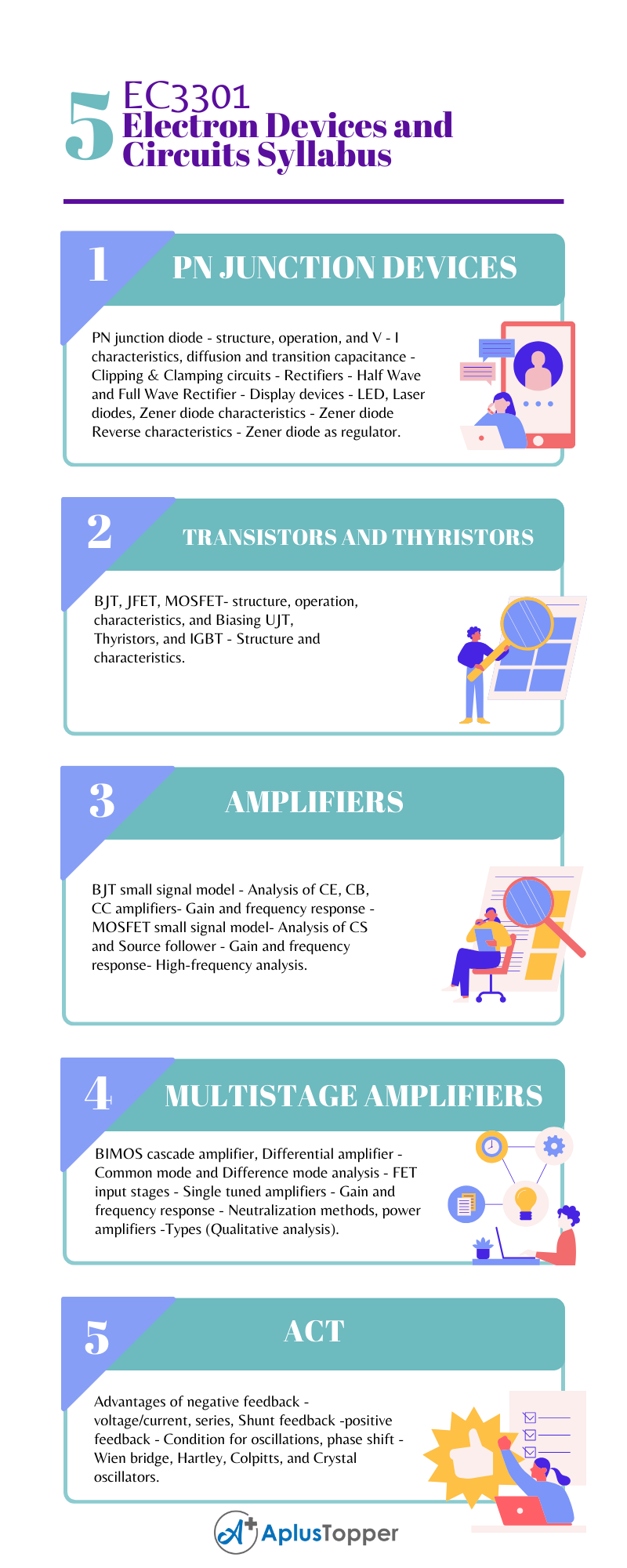The article contains the subject code EC3301, which deals with the Anna University B.E Electrical and Electronics Engineering Semester – III Electron Devices and Circuits Syllabus. Unit wise detailed syllabus of this subject EC3301 is included in this article. You can get assistance for note preparation or can understand the chapters contain topics in one place.
Effective results need effective preparation and having the required knowledge of the topics included in the subject. If you want to perform well in academics proper guidance and the subject syllabus in mind are necessary, this article EC3301 – Electron Devices and Circuits Syllabus will fulfill the details regarding your preparation.
If you want to know more about the syllabus of B.E Electrical and Electronics Engineering connected to an affiliated institution’s four-year undergraduate degree program. We provide you with a detailed Year-wise, semester-wise, and Subject-wise syllabus in the following link B.E Electrical and Electronics Engineering Syllabus Anna University, Regulation 2021.
Aim Of Objectives:
- To understand the structure of basic electronic devices.
- To be exposed to active and passive circuit elements.
- To familiarize the operation and applications of transistors like BJT and FET.
- To explore the characteristics of amplifier gain and frequency response.
- To learn the required functionality of positive and negative feedback systems.
EC3301 – Electron Devices And Circuits Syllabus
Unit I: Pn Junction Devices
PN junction diode – structure, operation, and V – I characteristics, diffusion and transition capacitance – Clipping & Clamping circuits – Rectifiers – Half Wave and Full Wave Rectifier – Display devices – LED, Laser diodes, Zener diode characteristics – Zener diode Reverse characteristics – Zener diode as regulator.
Unit II: Transistors And Thyristors
BJT, JFET, MOSFET- structure, operation, characteristics, and Biasing UJT, Thyristors, and IGBT – Structure and characteristics.

Unit III: Amplifiers
BJT small signal model – Analysis of CE, CB, CC amplifiers- Gain and frequency response -MOSFET small signal model- Analysis of CS and Source follower – Gain and frequency response- High-frequency analysis.
Unit IV: Multistage Amplifiers And Differential Amplifiers
BIMOS cascade amplifier, Differential amplifier – Common mode and Difference mode analysis – FET input stages – Single tuned amplifiers – Gain and frequency response – Neutralization methods, power amplifiers -Types (Qualitative analysis).
Unit V: Feedback Amplifiers And Oscillators
Advantages of negative feedback – voltage/current, series, Shunt feedback -positive feedback – Condition for oscillations, phase shift – Wien bridge, Hartley, Colpitts, and Crystal oscillators.
Text Books:
- David A. Bell, ’’Electronic devices and circuits”, Oxford University higher education, 5th edition 2008.
- Sedra and Smith, “Microelectronic circuits”,7th Edition., Oxford University Press, 2017.
References:
- Balbir Kumar, Shail.B.Jain, “Electronic devices and circuits” PHI Learning Private Limited, 2nd edition 2014.
- Thomas L. Floyd, “Electronic devices” Conventional current version, Pearson Prentice Hall, 10th Edition, 2017.
- Donald A Neamen, “Electronic Circuit Analysis and Design” Tata McGraw Hill, 3rd Edition, 2003.
- Robert L.Boylestad, “Electronic devices and circuit theory”, 11th edition, Pearson Prentice Hall 2013.
- Robert B. Northrop, “Analysis and Application of Analog Electronic Circuits to Biomedical Instrumentation”, CRC Press, Second edition, 2012.
Related Posts Of Semester – III:
- MA3303 – Probability and Complex Functions
- EE3301 – Electromagnetic Fields
- EE3302 – Digital Logic Circuits
- EE3303 – Electrical Machines – I
- CS3353 – C Programming and Data Structures
